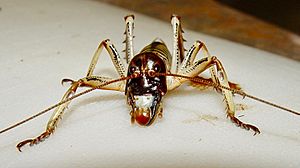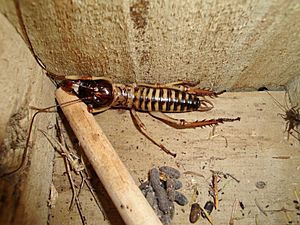Hawkes Bay tree weta facts for kids
Quick facts for kids Hawkes Bay tree weta |
|
|---|---|
 |
|
| Hemideina trewicki (male) | |
| Scientific classification | |
| Kingdom: | |
| Phylum: | |
| Class: | |
| Order: | |
| Suborder: | |
| Family: |
Anostostomatidae
|
| Genus: |
Hemideina
|
| Species: |
H. trewicki
|
| Binomial name | |
| Hemideina trewicki Morgan-Richards 1995
|
|
The Hawkes Bay tree weta, also known as Hemideina trewicki, is a large, cricket-like insect. It belongs to a group of insects called Orthoptera, which includes crickets and grasshoppers. This special weta lives only in New Zealand, specifically in the Hawke's Bay area on the North Island.
The Hawkes Bay tree weta is a cryptic species. This means it looks very similar to another weta, the Wellington tree weta (Hemideina crassidens). Even though they look alike, they are different species because they have a different number of chromosomes. All tree wetas in the Hemideina group are active at night (nocturnal). They cannot fly and they eat only plants (herbivores). During the day, they hide from animals that might eat them. They find shelter in hollow branches and cracks in trees. At night, they come out to search for leaves, flowers, and fruits to eat.
Contents
Where the Hawkes Bay Tree Weta Lives
The Hawkes Bay tree weta is common in forests and even in suburban gardens. You can find them across most of the Hawke's Bay region. In some areas, they live alongside the Auckland tree weta (H. thoracica). Sometimes, these two different weta species might even share the same hiding spots during the day. However, they rarely have babies together.
How to Identify a Hawkes Bay Tree Weta
The Hawkes Bay tree weta has black and yellow stripes on its back, similar to the Wellington tree weta. However, its neck area (called the pronotum) is pale with black marks. This pale neck area is like what you see on the Auckland tree weta. The Auckland tree weta, though, does not have the black and yellow stripes on its back. Its body color is more plain.
All tree wetas have very long antennae. They also have spines on their back legs. Adult wetas can bite if they feel threatened. To tell the Hawkes Bay tree weta apart from the Auckland tree weta, you can count the spines on their back legs. The Hawkes Bay tree weta usually has 8 spines on each back leg. The Auckland tree weta typically has 6 (or sometimes 7) spines on each back leg.
Life Cycle of the Hawkes Bay Tree Weta
Tree wetas are hemimetabolous insects. This means they hatch from eggs looking like small versions of the adults. They do not go through a pupa stage like butterflies do. Female wetas lay their eggs in the soil. The eggs hatch after about 8 months. The parents do not take care of their young.
Growing Up
Over about 12 months, the young wetas, called nymphs, grow larger. They shed their outer skin (molt) nine times as they get bigger. Eventually, they reach their full size, weighing about 8 to 12 grams. At this point, they are ready to have their own babies. The Hawkes Bay tree weta is smaller than the Auckland tree weta that lives in the same area. They also become adults earlier in the summer.
Mating and Family Life
During the late summer and autumn, adult female wetas often hide together in the same tree holes. Male wetas use special smells (chemical cues) to find other adult wetas. They will sometimes fight each other to get access to groups of females, which are called harems.


